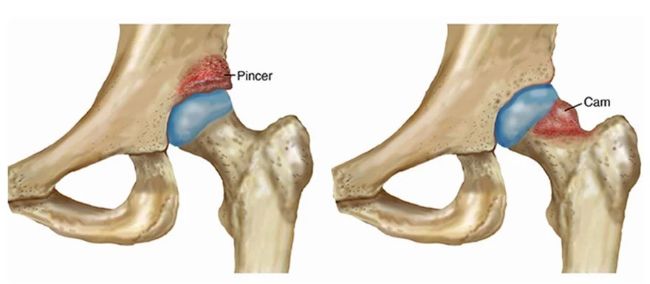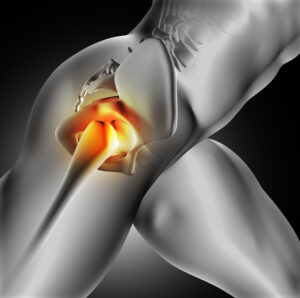Hip Impingement is technically known as Femoroacetabular Impingement, FAI is a hip joint with an odd form that rubs two hip bones against one another. The acetabulum and top of the femur (thighbone) rub together due to the pressure (part of the pelvis). FAI can impair movements and hurt.
FAI can harm the cartilage that cushions the hip if it is not treated. This damage could lead to painful joint deterioration or arthritis. To restore the damage, some people require surgery. FAI is likewise known as hip impingement.

Overview
What is Hip Impingement?
Hip impingement occurs when the bones comprising the ball and socket of the hip joint are misaligned and come into contact unnaturally. This improper fit can lead to friction within the joint, potentially resulting in damage to nearby tissues.
What are the Types of Femoroacetabular Impingement, FAI?
There are two primary types of hip impingement that doctors commonly discuss:
- Cam impingement: This type occurs when the spherical end of the thigh bone (femoral head) isn’t perfectly round, hindering its smooth movement within the hip socket.
- Pincer impingement: Pincer impingement involves excessive coverage of the femoral head by the hip socket (acetabulum). During hip flexion, the femur bone’s neck can bump against or impinge on the rim of the deep socket, causing damage to cartilage and the labrum.
- Combined impingement denotes irregular growth or development on both the femur and the acetabulum.
It’s worth noting that hip impingement can happen with or without osteoarthritis. In fact, untreated hip impingement is believed to contribute to osteoarthritis in many patients.
Symptoms & Causes
What are the symptoms of femoroacetabular impingement (FAI)?
While some individuals with FAI may not experience any symptoms initially, signs of the condition may become evident as hip damage progresses. These signs and symptoms include:
- Groin pain during or after physical activity or prolonged sitting.
- Limited ability to flex the hip beyond a certain angle.
- Stiffness in the hip.
- Difficulty ascending stairs.
- Limping.
- Decreased balance.
- pain in hips.
Causes
What leads to hip impingement?
- The precise cause of the irregular bone shape associated with hip impingement remains unknown. It’s believed that this abnormal bone formation occurs during the developmental stages of a child’s hip joints. However, the exact reasons for this occurrence are still uncertain to doctors and researchers.
- In some cases, hip impingement can be a result of other hip conditions like slipped capital femoral epiphysis (SCFE) and Legg-Calve-Perthes disease.
- While physically active individuals may experience symptoms earlier than those who are less active, it’s important to note that exercise itself does not cause hip impingement.
Diagnosis
- Imaging examinations: Procedures like X-rays and MRIs aid physicians in pinpointing irregularities and indications of damage within the hip joint.
- Impingement test: Your doctor conducts a test wherein your knee is brought up to your chest and rotated towards the opposite shoulder. Individuals with FAI typically experience similar discomfort during this movement.
- Local anesthetic: FAI can be identified by a doctor through the administration of numbing medication into the hip joint, observing if the injection alleviates pain.
- Physical examination: A thorough physical assessment allows your doctor to evaluate factors such as range of motion, muscle strength, and gait patterns to ascertain the functionality of the hip joint.
Treatment
Treatment for impingement of hip should initially focus on:
Non-Surgical Approach
- Allowing the affected hip to rest.
- Adjusting activities to prevent movements that provoke pain.
- Following prescribed exercises from your doctor or physical therapist to enhance the strength of the hip-supporting muscles.
- Consulting with physical therapists specialized in hip rehabilitation can significantly aid in muscle strengthening and inflammation relief around the hip.
- Using anti-inflammatory and pain-relieving medications as directed.
Surgical Approach
- Arthroscopic hip surgery: This minimally invasive method entails a surgeon repairing or removing damaged bone or cartilage.
- Conventional hip surgery: In more severe instances, surgeons perform an open operation, making a larger incision to address the damage.
Complications
What are the potential complications of femoroacetabular impingement (FAI)?
Individuals with untreated FAI may develop hip osteoarthritis, characterized by the deterioration of cartilage surrounding the hip joint. This complication can result in significant pain and restricted mobility.
Key Points:
- The prevalence of impingement syndrome of hip in the general population remains unknown.
- Hip impingement frequently impacts active adolescents and young adults.
- Neglected hip impingement could progress to hip osteoarthritis.
- Surgical intervention for hip impingement demonstrates success in roughly 80% of patients during short-term follow-up.